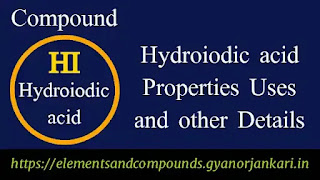Hydroiodic acid Properties Uses and other Details
What is Hydroiodic acid
Hydroiodic acid is a compound. Its chemical formula is HI.
Hydroiodic acid is a colorless and extremely strong acid, which is formed by
dissolving hydrogen iodide gas in water. The most acidic of the
hydrohalides, it is also known as hydrogen iodide and hydrodic acid. The
chemical formula for both hydroiodic acid and hydrogen iodide gas is HI.
Hydroiodic acid is a strong acid commonly used as a reducing agent. This
acid, in its anhydrous form, is composed of one hydrogen and one iodine
atom.
Properties of Hydroiodic acid
- Hydroiodic acid is a colorless liquid with an unpleasant odor.
- This acid reacts with oxygen in the air to give iodine.
- It produces thick white smoke in moist air.
- Its density is 1.7 grams per cubic centimeter.
- Its molar mass is 127.91 g/mol.
- The melting point of hydrogen iodide gas is -50.8 °C and the boiling point is -35.5 °C.
- The melting point and boiling point of hydroiodic acid depend on the concentration of hydrogen iodide gas in the aqueous solution.
- Hydroiodic acid is a strong acid that completely ionizes or dissociates in any aqueous solution.
- Hydroiodic is a powerful reducing agent and is a highly corrosive acid.
- It can react violently with metal powder and ammonia to produce explosion and fire.
- It is highly corrosive and reacts strongly with alkalis.
- Hydroiodic acid decomposes on heating to produce toxic fumes and is rapidly oxidized in air.
- When hydroiodic acid reacts with nitric acid, it produces iodine, nitrogen oxides, and water. 2HNO3 + 6HI → 2NO + 3I2 + 4H2O.
- When hydroiodic acid reacts with a strong base such as sodium hydroxide, it produces sodium iodide and water. HI + NaOH → NaI + H2O.
Uses of Hydroiodic acid
- One of the most important uses of hydroiodic acid is its reaction with alkynes or primary alcohols to form alkyl iodides, an important class of organic compounds.
- Hydroiodic acid is a common reducing agent for a variety of industrial purposes.
- Hydroiodic acid is used as a catalyst in many chemical reactions, such as in the production of acetic acid.
- Hydroiodic acid One of the primary iodine sources in organic and inorganic synthesis.
- Hydrocyanic acid's high level of acidity allows it to kill many types of germs and viruses, so it is often used to disinfect and clean medical equipment and products.
- Hydroiodic acid also serves as a pharmaceutical intermediate. Chemicals that are added to another chemical mixture so that it reacts to change into another compound are pharmaceutical intermediates.
- It is used in the manufacture of many medicines like malaria infection and chronic bronchitis.
- In organic chemistry, hydroiodic acid is used to prepare iodo compounds, such as iodoalkanes, alkyl magnesium iodides, iodobenzene, and other aromatic benzene derivative compounds.
- It is used as a good reducing agent in both organic and inorganic chemistry. It is also used as a laboratory reagent.
Other Details
- Aqueous solution of hydrogen iodide, i.e. hydroiodic acid is very strong acid in nature. It is stronger than hydrofluoric acid HF, hydrochloric acid HCL, and hydrobromic acid HBr, because hydroiodic acid is completely ionized in aqueous solution.
- Hydroiodic acid is a corrosive liquid, which can cause burns if it comes in contact with the skin. Contact of acid with eyes can cause severe burns. Hydroiodic acid can cause severe skin irritation and eye damage, and is highly toxic when inhaled, ingested, or absorbed through the skin. Prolonged exposure to low concentrations can also cause adverse health effects.
- HI gas is toxic by inhalation and is highly irritating to the skin, eyes and mucous membranes.
- The patient who has inhaled its vapor should be immediately taken away from the contaminated area, kept at rest and kept warm. In case of accidental splash in eyes, rinse immediately with plenty of water for 15 minutes. Contact with skin, wash immediately with plenty of water. If swallowed, rinse mouth with water immediately and take to hospital for treatment.
- Hydroiodic acid is a non-combustible substance, and does not self-ignite but it may decompose when heated to produce corrosive and/or toxic fumes. Can ignite some oxidizers and flammable materials (such as wood, paper, oil, fabric, etc.). Contact with metals may generate heat and flammable hydrogen gas. Due to which when heated, the cans can also burst.
Detailed Information on Some other Compounds







No comments:
Post a Comment